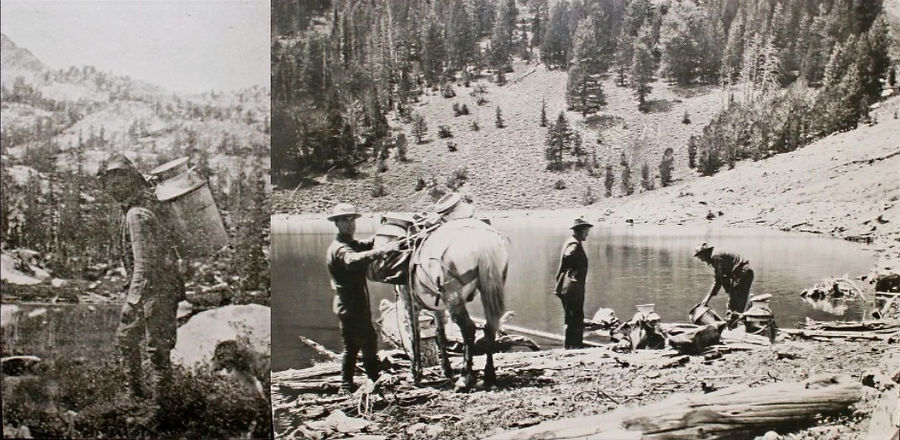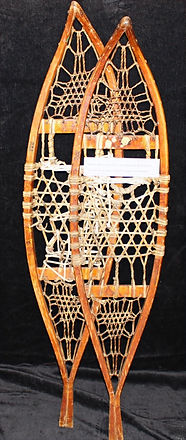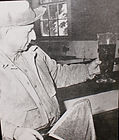EARLY TOOLS, EQUIPMENT AND TECHNIQUES
How They Got it Done

MILK CANS
For more than 50 years, milk cans were the preferred fish and/or fish egg shipping container. Wrapping the cans with wet burlap help cool the tiny fish inside.
Look for milk cans in many of the display photos.

EARLY FISH PASSAGE SYSTEM
1905
Buck Fishway on left; endorsed by State Game Warden W. N. Stephens; Georgetown Canyon.

STATE FISH CAR
1910
State Game Warden W. N. Stephens recommends “...this department should be provided a properly equipped fish car…” “On numerous occasions, if we had such a car, a greater number of fry could have been distributed in the waters of the state”. In use by 1911.

ALPINE LAKE FISH PLANTING
1921
Fish planting in alpine lakes were often done using horses or mules. Milk cans were placed in saddle bags or panniers.

WOOD FRAME BACKPACK
Circa 1960's
Canvas and wood pack frames like this were used to haul metal, and later plastic bottles into alpine lakes and streams to plant fish.

RED FISH LAKE
1921
Several gentlemen using boats to plant fish in Red Fish Lake, located at the foot of the iconic Sawtooth Mountain Range. Note the metal milk cans that were often used to transport fish.

RESEARCH AND MONITORING
early 1900's onward
Understanding the fishery is more than just stocking fish. Assessing and monitoring water quality, productivity and post release success is critical to the supplementation goals. Pictured are numerous tools commonly used to assess these factors. Items include (left to right): bottom dredge sampler, plankton net (hanging), thermometer, water quality test kit, stream flow meter, oak basket trap (hanging), scuba diving gear.

SNOW SHOES
circa 1940's
These were used at the Sandpoint Fish Hatchery to check water supply pipes in the winter.

PACKSTRING STOCKING
1920
Horses waiting for fish in milk cans to be loaded in saddlebags to reach mountain lakes and streams.

FISH MEASURING BOARD
circa 1940's-50's
This fish measuring board likely looks familiar to anyone who has needed to measure fish length. Note the name on the wooden measuring rule (Boise Blue Print Co.).

STOCKING FISH
1920
A horse drawn fish stocking event. Like today, this excitement draws some younger helpers to assist in planting the fish.

BOISE RIVER
1928
The Ada County Fish & Game League stocking fish in the Boise River. Notice the number of large milk cans on the truck bed. Local sportsmen's groups like this were extremely influential in assisting with conservation efforts early on and still today.

DEVELOPMENT OF MODERN FISH TRANSPORT TANKS
1929
Policy adopted for stocking fingerling fish (1” – 3”) instead of fry (<1”) and the distribution by Oxy – Fish tanks.

ANTIQUE MEASURING JAR
circa 1910-30's
Glass measuring jars like this were used to measure quantities of eggs and small fish. Note the hand etching of the measurement units.

GLASS JAR IN USE
1920's
Interior view of hatchery while worker measures either small fish or eggs using glass jar. The displacement of water in the jar is used to measure the volume o (a common technique used today). We believe the man holding the jar is Alan Clark at the Coeur D'Alene state hatchery.

CHASE HATCHING JARS
circa 1930's
The very gradual, gentle and continual rolling movement of the eggs upon each other in the jar prevents the formation of fungus that can otherwise spread quickly. Water enters the jar through a center tube and spills out the lip, where newly hatched fry can go directly into a rearing trough. Dead eggs rise to the top where they can be easily removed. Hatching jars like this (though now typically made of plastic or acrylic) are still commonly used to incubate and hatch post-eye fish eggs.

FIRST AERIAL STOCKING
1938
First aerial fish stocking in Idaho; from Twin Falls Airport to Clear Lakes; Lionel Dean/Gus Kelker.

HEAVY DUTY MEAT GRINDER
ST MARIES ICE HOUSE
1940's
This meat grinder was used during the 1940's and 50's to grind horse meat which was used at that time for fish feed at the Fernwood Hatchery holding ponds. Upon closure of the St Maries Ice House, this meat grinder was salvaged by then retired IDFG employee, Walter R. Browne who donated it to the IDFG collection.

FIRST HELICOPTER STOCKING FLIGHTS
1955
The first fish stocked by helicopter were released in Callahan Lake near Bonners Ferry.

VON BAYER EGG MEASUREMENT TROUGH
circa 1950's
This fairly crude, yet effective device measures the size of fish eggs based on the number that will fit side by side in the v-trough and can then be converted into a # of eggs per oz.

HANDMADE, ADJUSTABLE GRADER
circa 1980's
This unique fish grader design is a good representation of the enginuity needed by hatchery staff. The frame of this box twists out of square to adjust the spacing between the pickets, which allow fish of certain sizes to be segregated. We believe this grader was designed and built by Dan Beers.

ANOTHER HANDMADE GRADER
circa 1980's
This handmade grader features two rows of adjustable wooden grader bars. This is another unique, handcrafted grader used to segregate small fish based on size. Likely another Dan Beers design.
